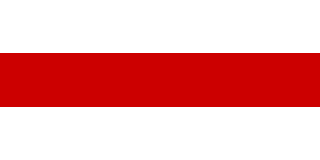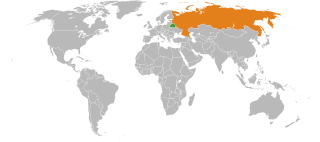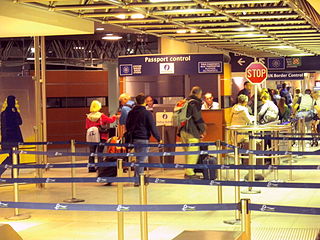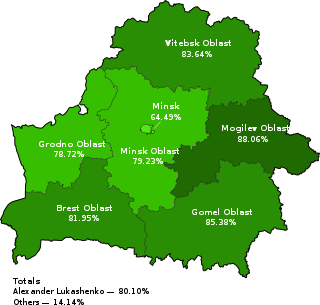
The politics of Belarus takes place in a framework of a presidential republic with a bicameral parliament. The President of Belarus is the head of state. Executive power is nominally exercised by the government, at its top sits a ceremonial prime minister, appointed directly by the President. Legislative power is de jure vested in the bicameral parliament, the National Assembly, however the president may enact decrees that are executed the same way as laws, for undisputed time.

Grodno or Hrodna is a city in western Belarus. It is one of the oldest cities of Belarus. The city is located on the Neman River, 300 kilometres (190 mi) from Minsk, about 15 kilometres (9.3 mi) from the border with Poland, and 30 kilometres (19 mi) from the border with Lithuania. As of 2023, the city has a population of 358,717 inhabitants. Grodno serves as the administrative center of Grodno Region and Grodno District, though it is administratively separated from the district.

Border control comprises measures taken by governments to monitor and regulate the movement of people, animals, and goods across land, air, and maritime borders. While border control is typically associated with international borders, it also encompasses controls imposed on internal borders within a single state.
Narodnaja Volya is an independent opposition newspaper founded by Iosif Siaredzich.
Belavia, formally Belavia Belarusian Airlines, is the flag carrier of Belarus, headquartered in Minsk. The state-owned company had, as of 2007, 1,017 employees. Belavia serves a network of routes between Commonwealth of Independent States, as well as some Middle East destinations, from its base at Minsk National Airport.

The Belarusian People's Republic, or Belarusian Democratic Republic, was a state proclaimed by the Council of the Belarusian Democratic Republic in its Second Constituent Charter on 9 March 1918 during World War I. The Council proclaimed the Belarusian Democratic Republic independent in its Third Constituent Charter on 25 March 1918 during the occupation of contemporary Belarus by the Imperial German Army.

Minsk National Airport, formerly known as Minsk-2, is the main international airport in Belarus, located 42 km (26 mi) to the east of the capital Minsk. It geographically lies in the territory of Smalyavichy Raion but is administratively subordinated to the Kastrychnitski District of Minsk. The airport serves as hub of the Belarusian flag carrier Belavia and the cargo carriers TAE Avia, Genex, and Rubystar Airways.

Belarus and Russia share a land border and constitute the supranational Union State. Several treaties have been concluded between the two nations bilaterally. Russia is Belarus' largest and most important economic and political partner. Both are members of various international organizations, including the Commonwealth of Independent States, the Eurasian Economic Union, the Collective Security Treaty Organization, and the United Nations.
Migration card is an identity document in the Union State of Russia and Belarus for foreign nationals. Originally they were bilingual (Russian/English), but were changed into Russian-only. The responses to the questionnaire in it may still be completed in English.

The Astravets Nuclear Power Plant is a nuclear power plant located in the Astravyets District, Grodno Region in north-western Belarus. The power plant is built close to the Belarus-Lithuania border, being 40 kilometres (25 mi) east of the Lithuanian capital of Vilnius. The plant is powered by two 1194-MW VVER-1200 units supplied by Atomstroyexport, the nuclear equipment exporter branch of the Russian nuclear corporation Rosatom. The plant is owned by State Enterprise Belarusian NPP, which in turn is owned by the state-owned operator Belenergo.

The Schengen Area is an area encompassing 27 European countries that have officially abolished border controls at their mutual borders. Being an element within the wider area of freedom, security and justice policy of the European Union (EU), it mostly functions as a single jurisdiction under a common visa policy for international travel purposes. The area is named after the 1985 Schengen Agreement and the 1990 Schengen Convention, both signed in Schengen, Luxembourg.

Belarus and Lithuania established diplomatic relations on 24 October 1991, shortly after the dissolution of the Soviet Union. The two countries share 680 kilometres (420 mi) of common border. Lithuania's border with Belarus is the country's longest border. For Belarus it is its 3rd-longest border.

Belposhta or Belpochta is the national postal service of Belarus. It became a member of the Universal Postal Union in 1947.

Visitors to Belarus must obtain a visa from one of the Belarusian diplomatic missions unless they are citizens of one of the visa-exempt countries.

Juxtaposed controls are a reciprocal arrangement between Belgium, France, the Netherlands and the United Kingdom whereby border controls on certain cross-Channel routes take place before boarding the train or ferry, rather than upon arrival after disembarkation. With the exception of the Eurotunnel Shuttle route, customs checks remain unaffected by juxtaposed immigration controls and continue to take place upon arrival after disembarkation. Belgium, France and the Netherlands are all member states of the European Union and part of the border-free Schengen Area. The United Kingdom, on the other hand, has never participated in the Schengen Area, even when it was a member state of the European Union. As a result, juxtaposed controls aim to increase the convenience and efficiency of border checks when travelling by train or ferry between the Schengen Area and the UK by removing the need for immigration checks on arrival and by streamlining checks on departure. At the same time, juxtaposed controls are intended to detect and prevent illegal immigration. In 2016, there were over 56,000 instances when people were refused entry to the UK at the juxtaposed controls.

The Belarusian-Ukrainian border is the state border between Belarus and Ukraine with a length of about 1,084 km (674 mi). It starts from the triple junction with Poland to the west and stretches to the triple junction with Russia to the east. The tripoint border at the triple border junction of Belarus, Russia and Ukraine is marked in the form of a monument, while at the other border junction there is a river, the Western Bug that coincides with the border of Poland.
Russian embargo of Ukrainian goods refers to trade sanctions Russia launched against Ukraine starting in July and August 2013.

Presidential elections were held in Belarus on Sunday, 9 August 2020. Early voting began on 4 August and ran until 8 August.

Belarus, a close ally of Russia, has supported its eastern neighbour in the Russian invasion of Ukraine. Before the start of the offensive, Belarus allowed the Russian Armed Forces to perform weeks-long military drills on its territory; however, the Russian troops did not exit the country after they were supposed to finish. Belarus allowed Russia to stage part of the invasion from its territory, giving Russia the shortest possible land route to Ukraine's capital, Kyiv. However, these forces withdrew within two months, thus ceasing land-based military operations originating from Belarus and resulting in the recapture of the Ukrainian side of the border region by Ukraine. Despite this, the situation along the border remains tense, with Ukraine closing the border checkpoints leading into Belarus, bar special cases.
Controls imposed on internal borders within a single state or territory include measures taken by governments to monitor and regulate the movement of people, animals, and goods across land, air, and maritime borders through border controls.














